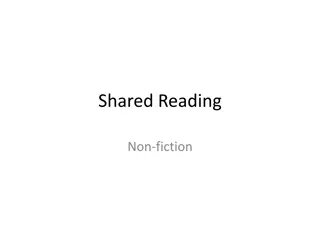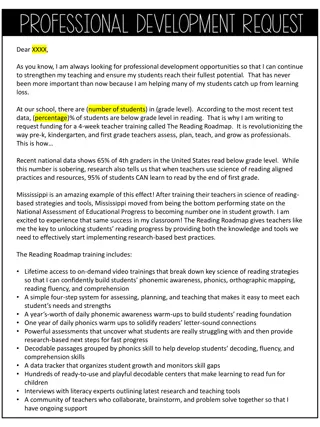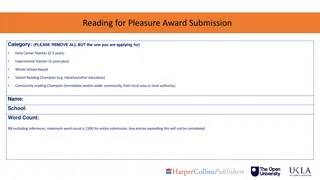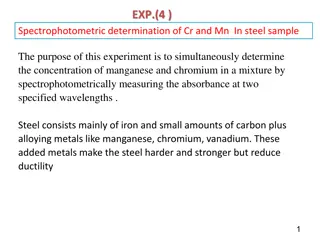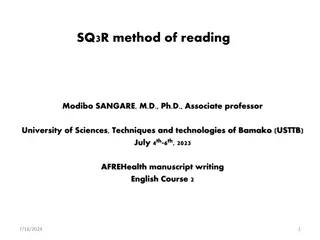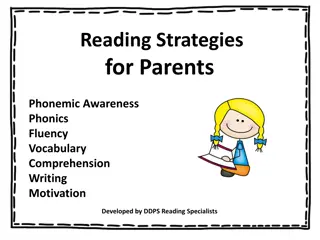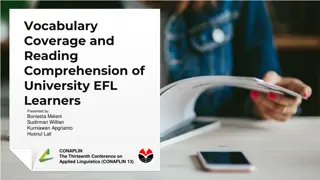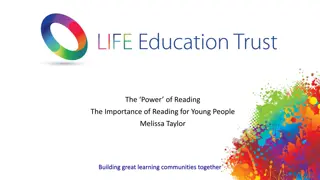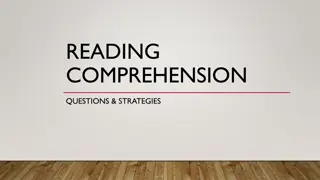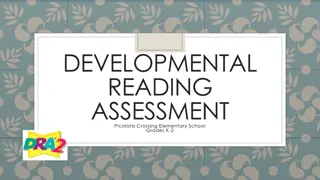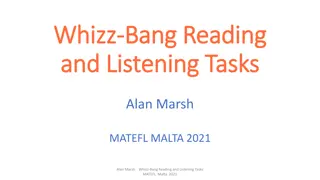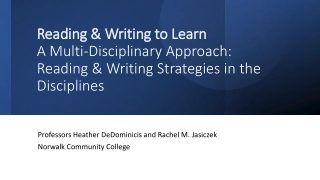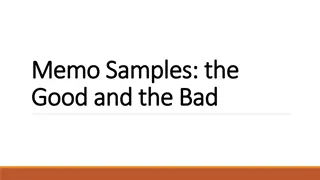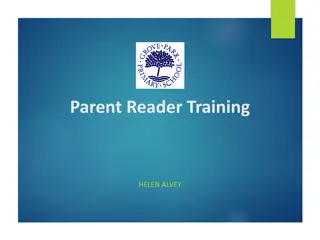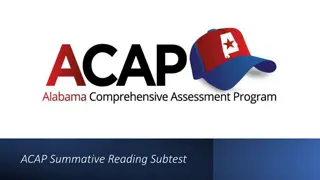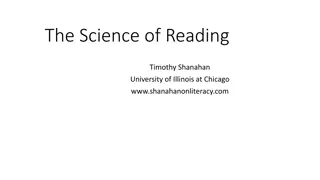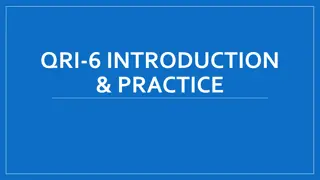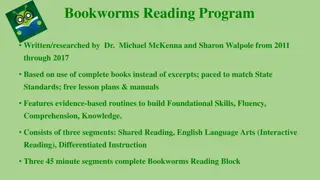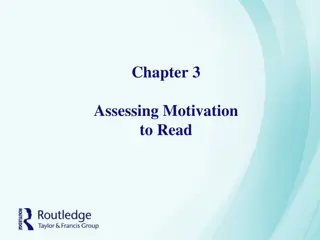Developing Effective Reading Work Samples
Creating reading work samples involves steps like identifying a topic, analyzing passages, drafting tasks, formatting, administering, scoring, and revising tasks. Considerations include text complexity, high student interest, and grade-level appropriateness. Text complexity is assessed quantitatively and qualitatively, taking into account reader background knowledge and task demands. Quantitative measures include word difficulty, sentence length, and text cohesion. Utilize resources like Lexiles for measuring text complexity.
Download Presentation

Please find below an Image/Link to download the presentation.
The content on the website is provided AS IS for your information and personal use only. It may not be sold, licensed, or shared on other websites without obtaining consent from the author. Download presentation by click this link. If you encounter any issues during the download, it is possible that the publisher has removed the file from their server.
E N D
Presentation Transcript
Characteristics of Work Samples Require student-initiated planning, management of information and ideas, interaction with a variety of other materials. Require production of extended responses, such as oral presentations, exhibitions, and other scorable products, including more extended writing responses which might be revised and edited. Reflect a real-world task and/or scenario-based problem; tasks are multi-stepped and allow for reflection and revision.
Creating a Reading Work Sample Step 1: Identify the Topic/Reading Passage Step 2: Analyze the Reading Passage Step 3: Draft the Reading Task Step 4: Format the Reading Task Step 5: Administer the Reading Task Step 6: Score the Reading Task Step 7: Analyze the Task Results Step 8: Revise the Reading Task
Creating a Reading Work Sample Step 1: Identify the Topic/Reading Passage Questions for Consideration: Curriculum-embedded? Part of a thematic unit? A stand-alone assessment? Is the topic/reading material of high interest to students? Is the passage rich enough to support analysis? Is the subject matter appropriate for this grade level?
Creating a Reading Work Sample Step 2: Analyze the Reading Passage Considerations: Texts may be drawn from a variety of digital or media resources (traditional text, audio, video, graphics). Text should be of a suitable length and complexity (see the Guide for Developing Reading Tasks for more clarification). Text complexity should be evaluated on both Quantitative and Qualitative measures.
Determining Text Complexity Text complexity is determined by: 1. Quantitative measures readability and other scores of text complexity often best measured by computer software. 2. Qualitative measures levels of meaning, structure, language conventionality and clarity, and knowledge demands often best measured by an attentive human reader. 3. Reader and Task considerations background knowledge of reader, motivation, interests, and complexity generated by tasks assigned often best made by educators employing their professional judgment. Reader and Task
Determining Text Complexity Step 1: Quantitative Measures Measures such as: Word length Word frequency Word difficulty Sentence length Text length Text cohesion Reader and Task Lexiles is one quantitative measure of text complexity. Go to: https://lexile.com/
Determining Text Complexity Step 2: Qualitative Measures Measures such as: Levels of meaning Levels of purpose Structure Organization Language conventionality Language clarity Prior knowledge demands Reader and Task For a rubric developed as a qualitative measure of text complexity, you can go to: http://www.ccsso.org/Navigating_Text_Complexity/Check_ the_Specs.html
Determining Text Complexity Step 3: Reader and Task Considerations such as: Motivation Knowledge and experience Purpose for reading Complexity of task assigned regarding text Complexity of questions asked regarding text Reader and Task For Guiding Questions for Reader and Task Considerations: http://www.ccsso.org/Navigating_Text_Complexity/Check_ the_Specs.html
Creating a Reading Work Sample Step 3: Draft the Questions Considerations: Compose at least two questions for each of the three Reading Traits (Demonstrate Understanding, Develop an Interpretation, Analyze Text) Include graphic organizers, as appropriate, for responses to questions Keep the questions clear, concise, and remind students to provide support for their answers
Creating a Reading Work Sample Step 4: Format the Task Considerations: Carefully craft the directions and a brief introduction Select an appropriate font style and size Use formatting as a cue to comprehension (e.g., use bold or italics to emphasize key words) Allow margin space for margin notes Include graphic organizers as appropriate for responses to questions Allow adequate space for responses
Creating a Reading Work Sample Step 5: Administer the Task Considerations: Performance tasks are generally not timed; allow students sufficient time to do their best work Spread over multiple sessions, as needed Determine if accessibility options might be appropriate to allow students to engage in the task For reading tasks, additional tools or resources are generally not allowed.
Creating a Reading Work Sample Step 6: Score the Task Considerations: Select the appropriate rubric/scoring guide (Literary vs. Informational) Review exemplar papers or anchor sets to recalibrate, as needed, prior to scoring Consider, as appropriate, all responses provided by the student (margin notes and responses to questions and graphic organizers)
Creating a Reading Work Sample Step 7: Analyze the Results Questions for Consideration: Are there some items/aspects students consistently struggled with? Is this an instructional issue? Are there questions students seem to consistently misinterpret or misunderstand? What revision(s) might clarify what is being asked? Is there a lack of evidence to score a particular trait? Do you need another question or questions to provide this additional evidence?
Creating a Reading Work Sample Step 8: Revise the Task Considerations: Add additional questions, as needed, to elicit more evidence from student responses. Revise questions which turned out to be imprecise or ambiguous. Replace questions that didn t work with better ones. Revise directions so students have clear targets/ expectations.
Additional Work Sample Guidance Within a school, multiple tasks should be used to prevent students from sharing information about task content between test sessions. Students can be given some choice among reading selections to address interest and accessibility. Prose selections for reading work sample stimuli should be approximately 1000-2000 words. The recommended Lexile level for text difficulty for HS work samples is around 1070, but a range from 950- 1200 is reasonable.







